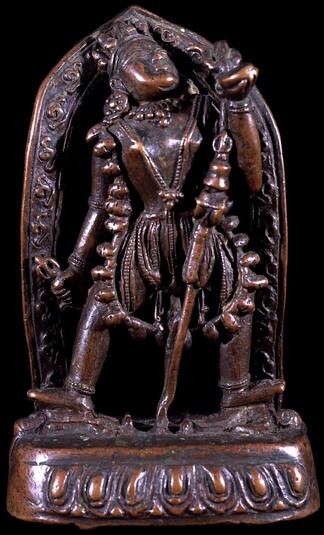
Item: Vajrayogini (Buddhist Deity) - (Naropa Tradition)
| Origin Location | Tibet |
|---|---|
| Date Range | 1400 - 1499 |
| Lineages | Buddhist |
| Size | 15.24cm (6in) high |
| Material | Bronze |
| Collection | Shelley & Donald Rubin |
| Catalogue # | acc.# P2001.18.6 |
Classification: Deity
Appearance: Semi-Peaceful
Gender: Female
Vajrayogini, the 'Khechari of Naropa' (Tibetan: dor je nal jor ma, na ro kha cho ma). Belonging to the Chakrasamvara collection of Tantras and one of the five principal tantric practices of the Sakya School.
Sanskrit: Vajrayogini Tibetan: Dor je nal jor ma
Tibetan: Dor je nal jor ma
Standing upright, with one face and two hands she holds a curved knife in the right and a skullcup upraised in the left. Resting on the left shoulder is a katvanga staff. Adorned with a tiara of skulls and ornaments she wears a necklace of fifty dry skulls standing with the two feet placed on the bodies of Kalaratri and Bhairava above a lotus seat. Completely encircled by the flames of pristine awareness she looks up to the pure realm of Khechara and drinks from the skullcup held aloft in the left hand.
Vajrayogini, is a representation of complete buddhahood in female form. Classified as Wisdom or 'Mother' Anuttarayoga Tantra the practices originate with the Chakrasamvara Cycle of Tantras. Although found in a variety of forms, she is common to all schools of Tibetan Buddhism. In this particular form she is a special teaching passed down from the lineage of the Indian mahasiddha Naropa through to the Sakya School. This form is also popular within the Gelugpa Tradition.
Guru Lineage: Vajradhara, Vajrayogini, mahasiddha Naropa, Pamtingpa, Sherab Tseg, Mal Lotsawa, Sachen Kunga Nyingpo, Sonam Tsemo, Dragpa Gyaltsen, Sakya Pandita, Chogyal Pagpa, etc.
Jeff Watt 5-98
Buddhist Deity: Vajrayogini Main Page
Sculpture: Metal
Sculpture: Female
Buddhist Deity: Vajrayogini Sculpture
Buddhist Deity: Vajrayogini, Khechara (Naropa Tradition)
Sculpture, Metal: Buddhist Deities
